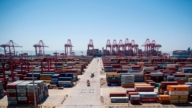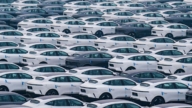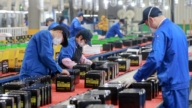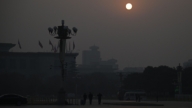【新唐人2013年08月03日讯】最近,中国大陆长沙远大集团计划修建世界第一高楼,引发许多争议。德国经济学家安德鲁•劳伦斯于1999年首先提出[摩天大楼指数]的概念,也被称为摩天大楼魔咒。他发现,摩天大楼与经济有着惊人的关联,经济衰退或股市萧条通常发生在摩天大楼建成前后。美国《彭博社》7月29号发表文章指出,中国目前的经济状态,难逃摩天大楼魔咒的厄运。
《彭博社》专栏作家白赛克(William Pesek)的文章比照了日本、马来西亚、阿联酋和美国在历史上建造摩天大楼与经济危机的密切联系。
白赛克举例说,1998年吉隆玻双子塔楼建成后,成为全球最大大楼,而股市和房地产投机却引爆了亚洲金融危机。十年后,阿联酋迪拜828米的哈利法塔成为世界第一高楼后,迪拜随即陷入经济危机之中。
《商业内幕》整理了过去140年全球11座与金融危机关系密切的摩天大楼的资料。发现摩天大楼指数预示经济衰退屡屡应验。摩天大楼热是标志着经济崩溃即将来临的一个可靠的指标。
北京天则经济研究所副所长冯兴元认为,摩天大楼指数确实有一定道理。
天则经济研究所副所长冯兴元:“当你经济高涨的很厉害的时候,可能衰退就快开始了。就是我们古代阴跟阳的关系。就是阴可以转成阳。月亮满了就要开始转向缺,缺了慢慢转向圆。经济高涨的时候,很多企业家出台一些大项目,但是等他出台的差不多的时候,经济开始衰退。”
白赛克针对中国列举了很多数据。例如,2012年统计资料显示,全球排名前20的高楼中,10座在中国。加上在建的高楼,到2014年,全球排名前20高楼,中国将独揽13座。他表示,以目前资产泡沫和地方政府巨额债务问题越来越严重的经济现状,中国恐遭遇摩天大楼魔咒厄运。
冯兴元:“如果有的话,已经中了。我们中国经济现在就在调整期。我们经济已经走向sluggish,sluggish指的是不景气。”
天则经济研究所所长助理段绍译观察表示,长沙没有必要建这样一个高楼,远大集团董事长张跃可能另有所图。
天则经济研究所所长助理段绍译:“也许他这个大楼根本就建不起来,只是一个炒作而已。但是哪一天他真的建起来了,按照远大现在的企业规模,他的项目可能会没有什么利润,可能会亏损,但是他同样很在乎摩天大楼产生的对他的品牌的宣传和推广。”
根据《2012中国摩天城市》报告,中国目前有470座摩天大楼,在建摩天大楼332座,另有516座已经完成土地拍卖、设计招标或已奠基。美国现有的533座摩天大楼,而在建及规划的摩天大楼只有30座。
针对中国近年来的摩天大楼热劳伦斯曾表示:“过于乐观的开发商,建设标志性建筑的政治愿望,以及非常乐于把钱借出去的银行,这些因素都会促成摩天大楼魔咒]。
远大集团宣称,天空之城将花六个月进行基础施工,四个月进行地面建筑。而一般来说,超高层建筑的建设周期需要5至10年。迪拜塔的建设就花了六年。
白赛克认为,中国经济快速和廉价的增长并不意味着中国已经建立了一个稳定,高效和多样化的经济。如果天空之城是经济学家衡量中国经济的唯一指标的话,那么中国经济已经深陷危机。
采访编辑/秦雪 后制/王明宇
Changsha Tallest Building Indicates China Set to Suffer Skyscraper Curse
Changsha City in China is set to build the world´s tallest
building, but it has been surrounded with controversies.
In 1999, German Economist Andrew Lawrence
first proposed “Skyscraper Index: Faulty Towers”.
It has also become known as the “Curse of the Skyscraper”.
Lawrence found that skyscraper construction
is correlated with economic recession.
Or, that stock market depression usually
occurs around skyscrapers being completed.
On July 29, Bloomberg commented
on China´s current economic situation.
It suggests China will have to be very
lucky to avoid the skyscraper curse.
William Pesek is a Bloomberg columnist.
He highlighted that in Japan, Malaysia, the United Arab
Emirates and the US, there was an uncanny correlation
between skyscrapers construction, and economic downturns.
William Pesek: “In the late 1990s, Kuala Lumpur´s
Petronas Towers opened at the height of the Asian crisis.
A decade later, Dubai´s economy hit a wall
right on cue, as the 828-meter Burj Khalifa
received its Guinness World Records mention.”
Business Insider studied 11 skyscrapers whose construction
correlated with a financial crises of that particular time.
They found that the skyscraper index has
predicted history´s worst financial crises.
Booms in skyscraper construction coincide
with the beginning of economic downturns.
Feng Xingyuan, Deputy Director of Beijing Unirule Institute
of Economics, thinks the skyscraper index does have logic.
Feng Xingyuan: “With an economic
upsurge, a recession may begin soon.
It is similar to the association of Yin and
Yang. Yin can be converted into Yang.
When the moon reaches its full phase,
it will gradually cycle back to dark.
Then it slowly comes back to full moon again.
When an economy upsurges, many
entrepreneurs launch some major projects.
After a period of time, recession begins.”
William Pesek draws on several statistics. In 2012,
China had 10 of the world´s tallest skyscrapers.
By 2014, China will have 13 of the
world´s top 20 tallest buildings.
Pesek said highlights China´s asset bubble,
and the growing local-government debts.
It seems set to suffer the skyscraper curse.
Feng Xingyuan: “If there is any
curse, China has already been hit.
China´s economy is in an adjustment period, and is sluggish.”
Duan Shaoyi, Assistant Director of Beijing
Unirule Institute of Economics commented.
It is unnecessary to build such a tall building in Changsha.
Zhang Yue, president of Broad Group,
is likely to have other intentions.
Duan Shaoyi: “Maybe the project won´t
be implemented, and it is just propaganda.
If it really will be constructed one day, according
to Broad Group´s financial capacity, there is no
profit in this project, and it may work at a loss.
However, they care about the skyscraper, as it brings
the advertisement and promotion for their brand.”
According to 2012 China Sky City report, China now has
470 skyscrapers. 332 skyscrapers are under construction.
There are 516 more scheduled to be built.
The US now has 533 skyscrapers, and there are 30
skyscrapers under construction, with others planned.
Regarding China, Andrew Lawrence said
that overly optimistic developers want
to build “landmark” political aspirations.
The banks are very happy to lend money, and
these factors will contribute to the “skyscraper curse.”
Broad Group claims that the “Sky City” project
will take 6 months for underground construction.
It will take a further 4 months for above ground construction.
Generally speaking, skyscrapers take 5-6 years to complete.
Burj Dubai took 6 years.
Pesek commented that China´s
economic growth is fast and cheap.
The growth does not mean that China has
created a stable, efficient or diverse economy.
If Broad Group´s “Sky City” project is the only indicator
available to economists, they would have to
conclude that China´s economy crisis was nigh.




























